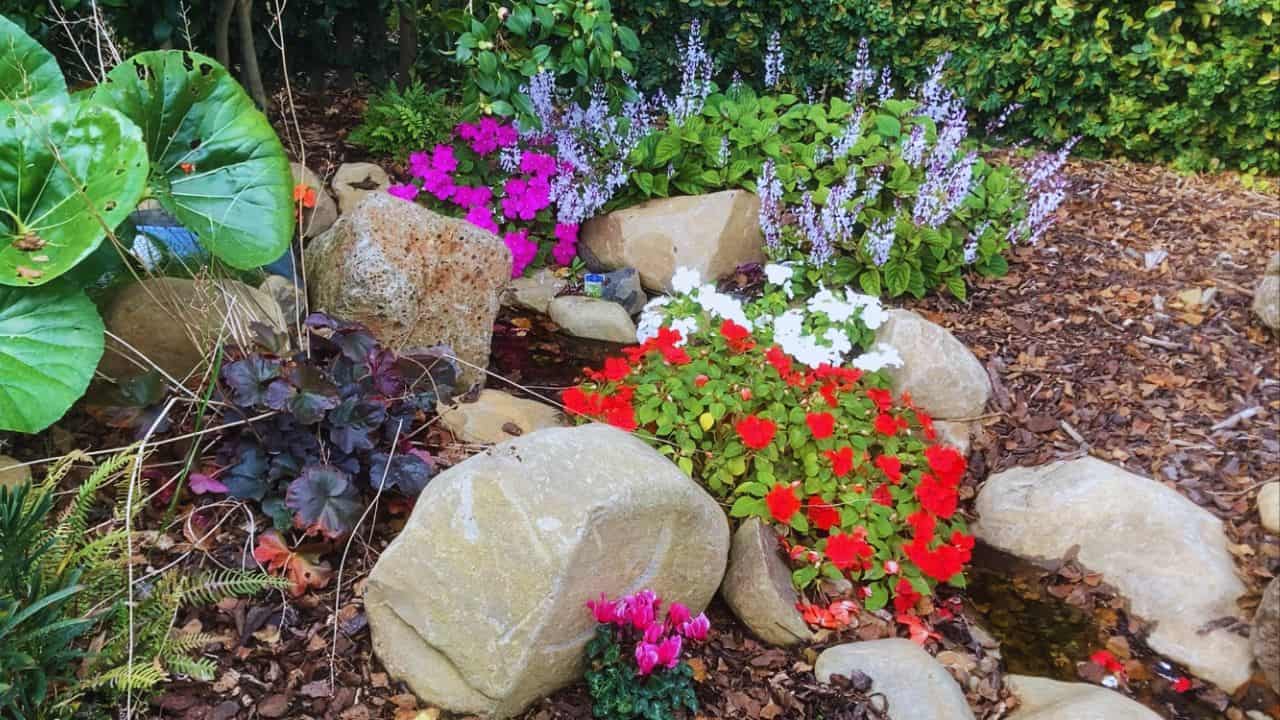Plants can significantly enhance the filtration of a pond, creating a healthier and more vibrant ecosystem.
In this post, I’ll explore the best plants for water filtration, tips on planting them, and how to save money by growing your own. If you prefer you can watch the video.
Riparian Plants: The Marginal Superstars
Riparian plants, those that grow on the margins of aquatic environments, are vital for effective pond filtration.
Their unique positioning allows them to have roots submerged in water while the majority of their foliage remains above the surface. This configuration makes them exceptionally efficient at nutrient absorption and sediment capture.
One of the key benefits of riparian plants is their ability to spread their root systems both into the substrate and the water. These roots consume nutrients stored in the substrate and directly from the water column.
By doing so, they help to reduce nutrient levels in the pond, which is crucial for maintaining water quality and preventing issues like algae blooms. Additionally, the roots that penetrate the substrate provide oxygen, creating an ideal environment for oxygen-loving bacteria to thrive.
These bacteria play a crucial role in breaking down organic materials and maintaining the pond’s overall health.
Riparian plants also contribute significantly to sediment control. As water flows through the root systems of these plants, sediments are trapped and held in place.
This not only helps to keep the water clear but also reduces the frequency of maintenance required to keep the pond clean.
Moreover, by stabilizing the substrate, riparian plants prevent erosion and create a more stable environment for other aquatic life.
Some of my personal favourite riparian plants
Remember, I’m in South-East Australia so some of these plants won’t be suitable for everyone but hopefully they give you some ideas for similar plants you could use in your part of the world.
For a more extensive list you might like to check out a post I wrote on 40 awesome pond plants.
Tall Plants:
- Rushes (e.g., Tassel Cord Rush)
- Ideal for adding height
- Easily propagated by division
Medium Plants:
- Dwarf Sweet Flag
- Prefers shaded areas over full sun
- Quick grower and easy to divide
- Milfoil
- Two types i like to use: Upright version and Red Stem version
- Grows quickly and stays on the pond margins
- Provides hiding places for baby fish
- Easy to propagate by cutting and replanting
Ferns:
- Maiden Hair Fern
- Rabbit Foot Fern
- Both suitable for shaded areas
- Can be used in larger ponds, bogs, and streams
Shade-Tolerant Medium Plants:
- Impatients
- Easy to propagate and aesthetically pleasing
- Dies off in winter but can be propagated from cuttings in spring
Ground Covers:
- Bacopa
- Spreads easily and is simple to pull up for nutrient removal
- Stays on the pond margins without venturing into deep water
- Excellent for trapping sediments and hiding pond liners
- Baby Tears
- Suitable for small leaved, shaded ground cover
Submerged Plants: The Oxygenators
One of the primary benefits of submerged plants is their role in oxygenation.
During photosynthesis, these plants release oxygen into the water, which is vital for the survival of aquatic organisms such as fish and beneficial bacteria.
By increasing oxygen levels, submerged plants promote a healthier environment and reduce the risk of oxygen depletion, especially in warmer weather when oxygen levels can decrease.
Some of my personal favourite oxygenators
Eelgrass:
- Eelgrass is known for its long, slender leaves and ability to form dense underwater meadows. It spreads by sending out runners and can create a lush habitat for aquatic organisms. Eelgrass is excellent for naturalizing pond bottoms and providing oxygenation throughout the water column.
Ludwigia:
- Ludwigia is prized for its vibrant foliage, which can range from bright green to reddish-purple, depending on the species. It adds a pop of color to the pond while also oxygenating the water. Ludwigia is relatively easy to care for and can thrive in various water conditions, making it a popular choice among pond enthusiasts.
Hornwort:
- Hornwort is a versatile submerged plant known for its dense growth and branching stems. It forms bushy clusters underwater, providing ample surface area for oxygen production and nutrient absorption. Hornwort is low-maintenance and can adapt well to different water parameters, making it suitable for both beginner and experienced pond keepers.
Floating Plants: The Shaders
One of the primary advantages of floating plants is their ability to extract nutrients directly from the water column.
By absorbing excess nutrients like nitrogen and phosphorus, floating plants help to mitigate algae growth and maintain water clarity. This nutrient uptake not only benefits the pond but also promotes a healthier environment for fish and other aquatic organisms.
Additionally, floating plants provide valuable shade, which is essential for regulating water temperature and reducing the risk of temperature fluctuations.
Cooler water holds more oxygen, so shading provided by floating plants can enhance oxygen levels and support aquatic life, especially during hot summer months.
The shade created by floating plants also helps to inhibit algae growth by limiting the amount of sunlight reaching the water’s surface.
Moreover, floating plants serve as habitat and refuge for various aquatic organisms, including fish, frogs, and insects. Their floating foliage offers shelter and spawning areas, contributing to biodiversity and ecological balance within the pond.
Some of my personal favourite floating plants
Duckweed:
- Duckweed is a small, fast-growing plant that forms a dense mat on the water’s surface. It has tiny leaves that float on the water, providing excellent nutrient uptake and shade. Duckweed is highly effective at absorbing excess nutrients and is often used to control algae growth in ponds.
Water-fringe:
- Water Fringe, is valued for its ability to spread and create new plants. It sends out runners that root into the substrate, producing new plants and expanding its coverage on the water’s surface. Water Fringe provides shade and habitat for aquatic life while adding beauty to the pond with its floating foliage.
Azolla:
- Azolla, also known as mosquito fern, is a floating fern that forms a dense carpet on the water’s surface. It has small, overlapping leaves that create a lush green mat, providing shade and habitat for fish, frogs, and insects. Azolla is effective at absorbing excess nutrients and is often used in natural pond filtration systems.
Planting Tips and Money-Saving Tricks
Growing your own pond plants through propagation is really easy. Below are the common methods.
1. Division:
- Many pond plants, such as rushes and dwarf sweet flag, can be easily propagated through division. Simply separate clumps of plants into smaller sections and replant them in suitable areas of the pond. This method allows you to multiply your plant stock without purchasing additional plants.
2. Cuttings:
- Several pond plants, including milfoil and impatiens, can be propagated from stem cuttings. Take cuttings from healthy plants and place them directly into wet substrate on the margins of the pond or bog filter.
3. Runners:
- Floating plants like water fringe produce runners that can be used to create new plants. Simply allow the runners to take root in the substrate or separate them from the parent plant and plant them in desired locations.
4. Natural Growth:
- Some pond plants, such as azolla and duckweed, propagate naturally ,provided there is enough nutrient. Allow these plants to grow and spread on their own, and periodically thin them out to control growth and prevent overcrowding. You can feed duckweed and azolla your chickens or place it on your compost pile.
Conclusion
Incorporating a diverse range of plants in your pond can create a robust and self-sustaining ecosystem. From riparian to submerged and floating plants, each type plays a unique role in filtration and overall pond health.
By growing your own plants and utilizing easy propagation methods, you can maintain a beautiful and functional pond without spending a fortune.
I hope you found this guide helpful, if you want to enhance your pond filtration with a bog filter or need more information on creating a pond ecosystem my pond building formulas page is a great resource. Thanks for reading!

